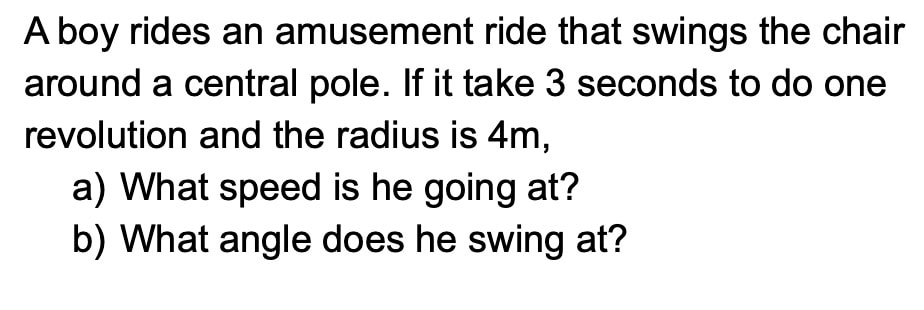
We all know what a circle is, but what are the principles that govern why an object moves in circles?
How do we discuss its motion when it travels in a circle? In the series of lessons which involves kinematics and dynamics, we will discuss what's exclamation is, how it's measured, some complex examples of circular motion, and the courses behind circular motion.
How do we discuss its motion when it travels in a circle? In the series of lessons which involves kinematics and dynamics, we will discuss what's exclamation is, how it's measured, some complex examples of circular motion, and the courses behind circular motion.
1a. Understanding Circular Motion
video
worked solutions
problems
interactive
video
|
|
This video cover the introduction of circular motion, including the forces involved |
|
|
A summary of the principles of circular motion, useful for review
|
worked solutions
problems
- An ant is riding on the tip of a 10 cm long secondhand of o'clock. Find the linear velocity of the ant. (62 cm/s)
- Calculate the centripetal force required to keep a 5 kg mass revolving in a circular path of radius 125 cm with a period of two seconds. (61.9 N)
- An astronaut is on a spinning space station so that he experiences artificial gravity, just like the film space Odyssey 2001. If the radius of the station is 1000 m, what will be the tangential velocity? (99 m/s)
- As you go around the corner at 72 km/h you experience a force of 1120 N from the seat of your car. If your mass is 70 kg what is the radius of the curve? (25m)
- A centripetal force of 8.94 N is required to keep an object in a circular orbit. What is the mass of the object if it is travelling with a constant speed of 8.10 m/s and a radius of 5.29 m? (0.72 kg)
interactive
A worksheet on centripetal motion problems
| w_centripetal_ph.pdf | |
| File Size: | 758 kb |
| File Type: | |
1b. The conical pendulum and banked curves explained
video
worked solution
problems
interactive
video
|
|
The conical pendulum and banking both are more complex examples of centripetal motion. This video examines these situations. An understanding of the basics of circular motion, normal and friction is assumed. |
|
|
A summary on the principles of banked curves, useful for review
|
worked solution
problems
1. A car (m = 1500kg) is travelling around a circular corner that has a radius of 20m. If the coefficient of the road surface to the tyres is 0.8.
a. What is the frictional force, the car experience in the turn?
b. What is the maximum speed that car can travel around the curve?
c. As it goes into the turn, it encounters a wet section that reduces μ to 0.5. Explain what happens to the car?
2. You are in a roller coaster that is approaching a circular loop, that has a diameter. Of 60m. You forgot to buckle in. What speed must you enter to to ensure you don't fall out (HINT: Apart from circular motion, you also need to consider conservation of energy, and assume negligible loss of energy due to friction)
3. A pendulum is rotating with a frequency of 1.5 Hz with a radius of 5 cm, as shown to the right. What is the angle?
4. A 70 tonne 737 makes a banking turn to come into land. If the radius is 2km and its speed is 300km/h a. What will be its banking angle? b. What would be the force it experiences to painting this turn (ie the Normal)
a. What is the frictional force, the car experience in the turn?
b. What is the maximum speed that car can travel around the curve?
c. As it goes into the turn, it encounters a wet section that reduces μ to 0.5. Explain what happens to the car?
2. You are in a roller coaster that is approaching a circular loop, that has a diameter. Of 60m. You forgot to buckle in. What speed must you enter to to ensure you don't fall out (HINT: Apart from circular motion, you also need to consider conservation of energy, and assume negligible loss of energy due to friction)
3. A pendulum is rotating with a frequency of 1.5 Hz with a radius of 5 cm, as shown to the right. What is the angle?
4. A 70 tonne 737 makes a banking turn to come into land. If the radius is 2km and its speed is 300km/h a. What will be its banking angle? b. What would be the force it experiences to painting this turn (ie the Normal)
interactive
2. An intro to angular velocity
video
worked solution
problems
resources
video
|
|
Measuring linear variables such has displacement and velocity in circular motions problematic. As a result, variables are based on angle not distance. This video gives you an intro |
worked solution
problems
coming soon
resources
3. Torque Explained
video
worked solution
problems
interactive
video
|
|
Torque is the rotational equivalent to force, in a rotational situation. This video examines how it works. |
worked solution
problems
interactive
Use this interactive to explore Torque using a seesaw analogy
4. What is moment of Inertia?
video
worked solution
going deeper
video
coming soon
worked solution
going deeper
4. Conservation of momentum in rotational mechanics
video
worked solution
going deeper
video
worked solution
going deeper
6. The physics of the roller coaster and looped tracks
videos
worked solution
going deeper
interactive
videos
|
|
Roller coasters provide a great way to examine physics concepts: everything from forces, momentum, and energy - from both a linear perspective and rotational. This covers these concepts and is here since loops are examined Many motion graph analysis video examine simplistic examples where velocity is constant or acceleration is constant. In this video I analyse a well known toy which has more complex motion, and I apply the same skills taught to analyse its graph. This video helps students consolidate their understanding of motion graphs, as well as review concepts such as friction, energy and forces. |
worked solution
going deeper
interactive
7. How well do you know circular motion?
video
more problems
video
coming soon
more problems





